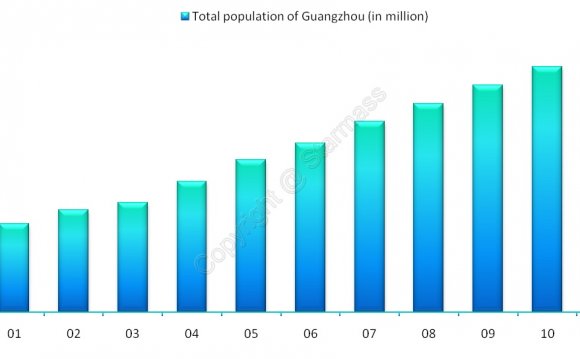
Guangzhou, known historically as Canton or Kwangchow, is the largest city and capital of China's Guangdong province. Located on the Pearl River approximately 120 kilometers northwest of Hong Kong, the city is one of 5 National Central Cities and a major international hub.
Guangzhou's population in 2013 has now reached 14 million, up from 12.78 million at the 2010 census. The urban population of Guangzhou is 11, 070, 654, with the remainder living in the rural areas of the city. The density of Guangzhou is now 1, 708 people per square kilometer, or 4, 425 people per square mile. While this certainly doesn't compare to the most densely populated cities in the world, some of which reach over 42, 000/sq km, it does leave room for additional growth in the years to come.
While Guangzhou's population is 14 million, The Pearl River Delta Economic Zone, which includes Guangzhou, Shenzhen, Foshan, Dongguan, Zhuhai, Jiangmen, Zhongshan and parts of Zhaoqing and Huizhou, has an estimated population of 40 million.
The region around Guangzhou is known for its huge influx of migrants, with up to 30 million additional migrants living in the area for at least 6 months out of every year. This huge influx of people from other areas, called the floating population, is due to the city's fast-growing economy and high labor demands.
Interestingly, many of the railroad laborers who worked in Panama, the United States and Canada during the 19th century came from Guangzhou and its surrounding areas. Many from this region also left to California during the 1849 gold rush, and to Australia a decade later. While emigration has slowed recently due to Guangzhou's economic prosperity, it's still a major source of immigrants to the rest of the world, especially North America.
Most of Guangzhou's population is Han Chinese, like most of China. The largest subgroup of Han Chinese in the region are the Cantonese people. Like the rest of China, Guangzhou has a very unbalanced gender ratio, but its province has a higher imbalance than the rest of the country. While most areas of China have 112-120 boys per 100 girls, the Guangdong province that houses Guangzhou has more than 130 boys for every 100 girls.
Guangzhou announced plans in 2012 to limit its population growth by 2020 as it faces a huge demand on overloaded services in the city, along with calls from residents to end or relax China's famous one-child policy by 2015.
Guangzhou mayor Wan Qingliang told an urban planning seminar that Guangzhou is facing a very serious population problem stating that, while the city had 10.33 million registered residents at the time with targets and scales of land use based on this number, the city actually had a population with migrants of nearly 15 million.
Guangzhou faces land shortage as well as shortages of public resources, and he estimated that the city's population will push past 18 million by 2020 without some sort of population control in effect to reduce the number of low-skilled workers and bring in more qualified people.
Guangzhou's natural birth rate has remained around 6.2% per year for many years, and the growth in the area has been primarily due to migrants from nearby provinces and cities. The number of migrants in Guangzhou increases by around 300, 000 each year.
According to the Guangzhou Academy of Social Sciences research Peng Peng, the city is almost at its maximum capacity of just 15 million, which means the city is facing a great strain, mostly due to a high population of unregistered people.
This means that Guangzhou is growing too fast for its infrastructure and public services, so its population should begin to stabilize somewhat if the government enacts the population controls its attempting. It will still remain one of the largest cities in China, and one of 8 cities in the country with a population of 10 million.









